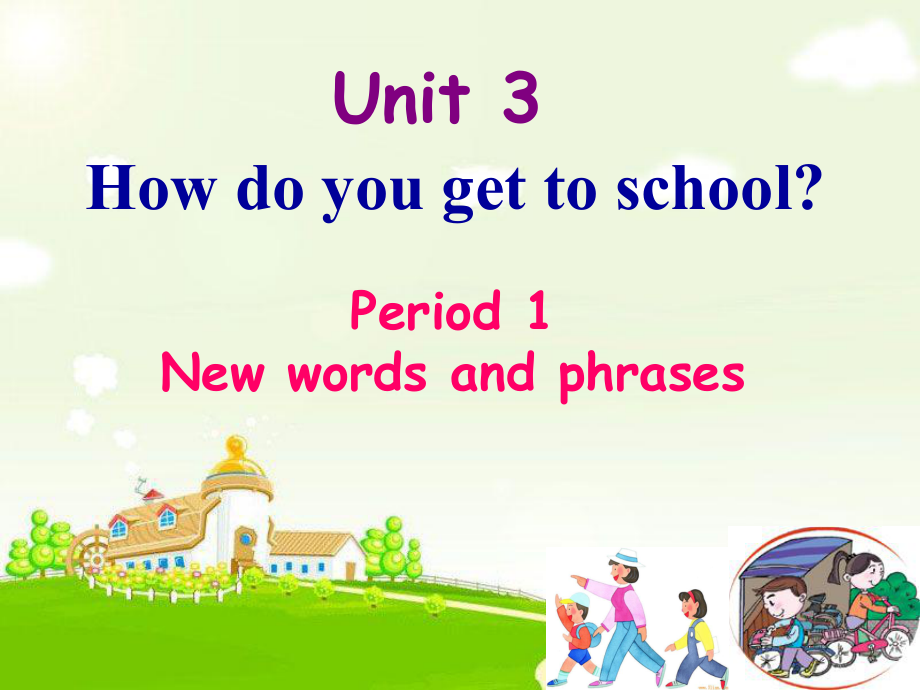《七年級英語下冊 Unit 3 How do you get to school(第1課時)New Words and phrases課件 (新版)人教新目標版》由會員分享�,可在線閱讀����,更多相關《七年級英語下冊 Unit 3 How do you get to school(第1課時)New Words and phrases課件 (新版)人教新目標版(14頁珍藏版)》請在裝配圖網(wǎng)上搜索。
1��、Unit 3How do you get to school?Period 1 New words and phrases1.能正確使用下列詞匯能正確使用下列詞匯(Curriculum words)train, bus, subway, boat, car, kilometer, minute, river, village, villager, bridge, year, dream, stop, ride, drive, live, cross, leave, far, many, new, every, afraid, true, sixty, seventy, eighty, nine
2�����、ty, hundred, by, between, like2.能正確使用下列常用表達能正確使用下列常用表達(Useful expressions)get to school, take the subway/bus/train, ride a bike, walk to school, by bike/bus/train, every day, bus stop, train/subway station, think of, come true3.能認讀下列詞匯能認讀下列詞匯: ropewayII.學習策略學習策略 能根據(jù)詞塊記憶詞匯能根據(jù)詞塊記憶詞匯III.了解因地域差異而造成的出行方式
3����、的差異。了解因地域差異而造成的出行方式的差異�����。Remember the words by looking at pictures.I take the train to school.He takes the bus to work.Many people take the subway.Jane rides her new bike to school.Dave drives his car to Tengzhou.The two girls go on a ropeway to school because theres no bridge and the river runs too q
4��、uickly for boats.A bridge is over the river.She takes the boat to work.Remember the words by listening and looking at pictures. trainbuscarRemember some places according to the pictures. Picture a is a train station.Picture b is a bus stop.Picture c is a bus station.Picture d is a subway station.Man
5、y villagers live in the far village. Theyre not afraid to cross the river because theres a bridge over it.Sixty minutes is an hour.1. six sixteen sixty 2.seven seventeen seventy 3.eight eighteen eighty 4.nine nineteen ninety Remember the words by their similar pronunciations and forms. Three hundred
6�、 and sixty-five days is a year.Remember the words by matching itself with its meaning.1.kilometer2.every3.by4.think e trueA. 真的;符合事實真的���;符合事實B. 介于介于 之間之間C. 夢想�;做夢夢想��;做夢D. 乘(交通工具)乘(交通工具)E. 認為認為F. 千米�����;公里千米��;公里G. 每一�;每個每一;每個H. 離開離開I. 實現(xiàn)����;成為現(xiàn)實實現(xiàn);成為現(xiàn)實J. 像����;怎么樣像;怎么樣 Read the story and underline the new words. In t
7�����、he countryside, it depends on(取決于取決于)where you are. In places (地方地方) where there are rivers and lakes(湖泊湖泊), like Weishanhu, students usually go to school by boat. But for some students in one small village, it is difficult. There is a very big river between their school and the village. There is no
8、 bridge and the river runs too quickly for boats. But the students arent afraid. They go on a ropeway to cross the river to school. Many of the students and villagers never leave the village. It is their dream to have a bridge. Can their dream come true? How do you get to school? Do you walk or ride
9����、 a bike? Do you know how students around China get to school? In cities, most students take the bus .Some students get to school by subway or by train. A small number of students in their parents cars. Others ride their bikes or walk to school. _ Read the story and translate it into Chinese. How do
10、you get to school? Do you walk or ride a bike? Do you know how students around China get to school? In cities, most students take the bus. Some students get to school by subway or by train. A small number of students in their parents cars. Others ride their bikes or walk to school. 其他的有其他的有步行步行或或騎自行
11���、車騎自行車去上學的。去上學的�。你如何你如何到校到校?你步行還是你步行還是騎自行車騎自行車�����?你知道中國各地的學生怎樣你知道中國各地的學生怎樣到校到校嗎�?嗎?在城市�,大部分學生在城市,大部分學生乘公交車乘公交車到校�。到校。一些學生一些學生乘地鐵乘地鐵或或火車火車到校��。到校�。一小部分學生坐他們父母的一小部分學生坐他們父母的小汽車小汽車去上學�����。去上學��。 Read the story and translate it into Chinese. In the countryside, it depends on(取決于取決于)where you are. In places (地方地方) where t
12���、here are rivers and lakes(湖泊湖泊), like Weishanhu, students usually go to school by boat. But for some students in one small village, it is difficult. There is a very big river between their school and the village. There is no bridge and the river runs too quickly for boats. So these students go on a
13、ropeway to cross the river to school. Many of the students and villagers never leave the village. It is their dream to have a bridge. Can their dream在come true?他們的他們的夢想夢想能能實現(xiàn)實現(xiàn)嗎�����?嗎����?農(nóng)村,取決于你住在哪里�。農(nóng)村,取決于你住在哪里�����。在有在有河流河流和湖泊的地方�����,像微山湖,學生們通常和湖泊的地方����,像微山湖,學生們通常乘船乘船去上學����。去上學。但是對于在一個小但是對于在一個小村莊村莊的某些學生來說�,上學是困難的。的某些學生來說
14�、,上學是困難的���。在在他們學校他們學校和和村莊村莊之間之間有一條大有一條大河河。 河面上沒有河面上沒有橋橋并且水流湍急無法并且水流湍急無法渡船渡船�。但這些學生不但這些學生不害怕害怕,他們�����,他們乘索道過河乘索道過河去上學��。去上學����。很多學生和很多學生和村民村民從沒從沒離開離開過村莊�。過村莊��。有一座有一座橋橋是他們的是他們的夢想夢想�����。How to get to school in China?countrysidecities Most take the bus 1 some2by subwayby train A small number 3in their parents cars others
15����、4ride their bikeswalkrivers, lakes one smallvillage 12by boata big river runs too quicklyno bridgego on a ropewayvillagers never leave to have a bridgeCan their dream come true?一、按要求寫出下列單詞或短語一����、按要求寫出下列單詞或短語。1.乘火車乘火車 _ 2.乘地鐵乘地鐵 _3.騎自行車騎自行車 _4.一百零五一百零五 _5.九十九九十九 _6.公共汽車站公共汽車站 _7.認為認為 _8.每天每天 _9.在在和和之間之
16�����、間 _10.實現(xiàn)實現(xiàn) _11.害怕害怕 _12.夢想夢想 _13.許多許多 _14.橋橋 _15.分鐘分鐘 _16.八十八十 _17.離開離開 _18.真的真的 _19.遠的遠的 _20.村莊村莊 _take the traintake the subwayride a bikeone hundred and fiveninety-ninebus stationthink ofevery daybetween and come trueafraiddreammanybridgeminuteeightyleavetruefarvillage二根據(jù)括號中的漢語意思完成句子二根據(jù)括號中的漢語意思完成
17�����、句子1. Does your father take the _(地鐵地鐵)to work?2. Sixty _ is an hour(分鐘分鐘).3. Fifty and fifty is one _.4. -How far is it from here? -About 3 _ (千米千米).5. There is a bridge _(在在和和之間之間)the village and the school.6.My father _(開車開車) to work every day.7.You should be careful when you _ (穿過穿過) the road.8.O
18、ur teacher is _ (像像) our parents.9. Mary _(騎騎) her bike to school every day.10.Dave _ (住住) about 5 kilometers from school.subwayminuteshundredkilometersbetweendrivescrosslikerideslives1.You must:2.If you can:Recite the words and useful expressions in Unit 3 correctly.2)Preview Section A 1a-2d.1)Write a story using the words and useful expressions in Unit 3.
 七年級英語下冊 Unit 3 How do you get to school(第1課時)New Words and phrases課件 (新版)人教新目標版
七年級英語下冊 Unit 3 How do you get to school(第1課時)New Words and phrases課件 (新版)人教新目標版

